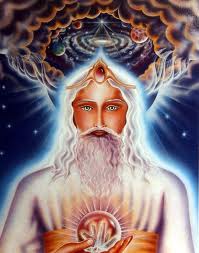Sanat kumara was one of the Four Kumaras, the four Manasputras (mind-born-sons) or spiritual sons of Brahma according to Puranic texts of Hinduism, including the Bhagavata Purana, whose other sons were Sanaka, Sanatana, and Sanandana. Sanatkumara in Sanskrit means “eternal youth”. Though in Mahabharata, total seven sons are mentioned, namely: Aniruddha, Sana, Sanatsujata, Sanaka, Sanandana, Sanatkumara, Kapila, and Sanatana and further mentions that,”Knowledge comes to these seven rishis, of itself (without being dependent on study or exertion). These seven are wedded to the religion of Nivritti (inward contemplation). They are the foremost of all persons conversant with Yoga. They are possessed also of deep knowledge of the Sankhya philosophy. They are preceptors of the scriptures on duty and it is they that introduce the duties of the religion of Nivritti (inward contemplation), and cause them to flow in the worlds”.
He is also the author of the Sanatkumara Samhita, which is part of the Shiva Purana, and has 59 chapters. It is also taken as a part of the Pañcaratra, Vaishnavite devotional texts.
The Chandogya Upanishad, Chapter seven, is about Sanatkumara’s Instructions on Bhuma-Vidya to celestial sage Narada, Sanatkumara finds mention across Mahabharta, as a great sage, who dispels doubts and the preceptor in all matters affecting Yoga.
According to the post-1900 publications of Theosophy, i.e. the writings of C. W. Leadbeater, Annie Besant, etc., as well as those authors influenced by the theosophical teachings such as Alice A. Bailey, and Benjamin Creme, and the Ascended Master Teachings of Guy Ballard, Elizabeth Clare Prophet, Geraldine Innocente, Joshua David Stone, and other Ascended Master Teachings / teachers, Lord Sanat Kumara is an “Advanced Being” at the Ninth level of initiation who is regarded as the ‘Lord’ or ‘Regent’ of Earth and of the humanity, and is thought to be the head of the Spiritual Hierarchy of Earth who dwells in Shamballah, (also known as ‘The City of Enoch’).
Sanat Kumara was mentioned briefly by the theosophist Helena Blavatsky.[9] She claimed he belonged to a group of beings, the “Lords of the Flame”, whom Christian tradition have misunderstood as Lucifer and the fallen angels.[10]
Sanat Kumara gained greater prominence when Blavatsky’s close-friend and colleague Charles W. Leadbeater wrote that Sanat Kumara was the “King” or Lord of the World, and the head of the Great White Brotherhood of Mahatmas who had revealed the principles of theosophy.[11]
Later authors who draw from Theosophical teachings such as Alice Bailey and Elizabeth Clare Prophet have embellished the story with further details. He is usually depicted as having the appearance of a 16 year old boy. It has been reported that he was seen by Parahamsa Yogananda’s Guru in 1897 during the Kumb Mela Festival. There are photos taken at an Ashram in central India in 1986 of a Guru who appears to be the same personage, looking around the age of 20, reputed to be yet another rare earthly incarnation of the Master on the Earth plane, which are strikingly similar to the portrait drawing of him in Yogananda’s Book.
Sanat Kumara is regarded as the great guru, saviour of Earth. Believers in him see him in all the major religions, as Skanda/Kartikkeya in Hinduism, Brahma-Sanam Kumar in Buddhism, the Ancient of Days in Judeo-Christian traditions, and identify him as Ahura Mazda in Zoroastrianism (although the last of these claims is contested from a lack of information on the subject). It is also considered that Sanat Kumara is Al Khdir (green man) known to Sufi Muslims (according to Dakshinamurti).
The most common title attributed to Lord Sanat Kumara in the Theosophical religious tradition is “Lord of the World”. C.W. Leadbeater also states that an important duty of Sanat Kumara is to participate in an elaborate ritual every Wesak (the Full Moon of May) led by Gautama Buddha, and also participated in by the Maitreya (the being Theosophists identify as Christ), in which cosmic energy is focused from the “Solar Logos” to Earth in order to keep our planet’s cosmic energy in balance. The ritual is said to take place in a ravine in southern Tibet (the Frontispiece of Leadbeater’s book The Masters and the Path has a picture of the ritual taking place) and, it is stated by Leadbeater, can be viewed by in the etheric body or in the physical body by those who have etheric sight.



Very good